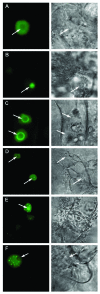Localization of eIF4A-III in the nucleolus and splicing speckles is an indicator of plant stress
- PMID: 20514231
- PMCID: PMC2819441
- DOI: 10.4161/psb.4.12.9906
Localization of eIF4A-III in the nucleolus and splicing speckles is an indicator of plant stress
Abstract
The mechanisms of long-term adaptation to low oxygen environment are quite well studied, but little is known about the sensing of oxygen shortage, the signal transduction and the shortterm effects of hypoxia in plant cells. We have found that an RNA helicase eIF4A-III, a putative component of the Exon Junction Complex, rapidly changes its pattern of localisation in the plant nucleus under hypoxic conditions. In normal cell growth conditions GFPeIF4A-III was mainly nucleoplasmic, but in hypoxia stress conditions it moved to the nucleolus and splicing speckles. This transition occurred within 15-20 min in Arabidopsis culture cells and seedling root cells, but took more than 2 h in tobacco BY-2 culture cells. Inhibition of respiration, transcription or phosphorylation in cells and ethanol treatment had similar effects to hypoxia. The most likely consequence is that a certain mRNA population will remain bound to the eIF4A-III and other mRNA processing proteins, rather than being transported from the nucleus to the cytoplasm, and thus its translation will be suspended.
Keywords: eIF4A-III; exon junction complex; hypoxia; nucleolus; splicing speckles.
Figures


Comment on
-
Dynamic behavior of Arabidopsis eIF4A-III, putative core protein of exon junction complex: fast relocation to nucleolus and splicing speckles under hypoxia.Plant Cell. 2009 May;21(5):1592-606. doi: 10.1105/tpc.108.060434. Epub 2009 May 12. Plant Cell. 2009. PMID: 19435936 Free PMC article.
References
-
- Branco-Price C, Kaiser KA, Jang CJ, Larive CK, Bailey-Serres J. Selective mRNA translation coordinates energetic and metabolic adjustments to cellular oxygen deprivation and reoxygenation in Arabidopsis thaliana. Plant J. 2008;56:743–755. - PubMed
-
- Dinneny JR, Long TA, Wang JY, Jung JW, Mace D, Pointer S, et al. Cell identity mediates the response of Arabidopsis roots to abiotic stress. Science. 2008;320:942–945. - PubMed
Publication types
Grants and funding
LinkOut - more resources
Full Text Sources
Miscellaneous
